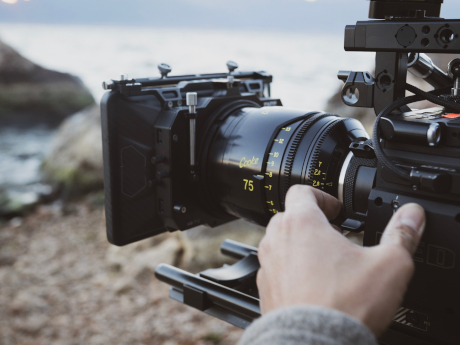Cooke Lenses Customer Interview 1: How Director Di Fan And Cinematographer Jacky Poon Used Cooke Panchro/i Classic Lenses To Present The Flaming Beauty Of Firenomads

FireNoMads captures a mesmerizing fire dance from Dali, China. The performance, which sees two dancers swirling with fire, is a visual spectacle and a feast for the eye. The subject matter is one that Director Di Fan and Cinematographer Jacky Poon are both passionate about, and they finally collaborated to produce this short demo film to showcase the RED GEMINI 5K camera. To realize their creative vision and bring out the vivid details of the fire dance, Jacky chose to shoot with Cooke Panchro/i Classic lenses. After the release of the film, they sat down to share their experience.
Di Fan is an independent director, producer and photographer. She focuses primarily on commercial and documentary short films and has worked extensively with globally-renowned brands and production companies. She is also known for her creative and time-lapse photography. Her signature work includes photography project Beijing/Sydney: Doublelife 100 Days, documentary series Dalifornia Dreams, and time-lapse photography Sunrise Plans. Website: www.fan-di.com.
Director Di Fan (left)
Jacky Poon is a wildlife and natural history photographer. A former Emmy Award nominee, he has shot many wildlife documentaries and films for companies such as the BBC, The Walt Disney Company, and National Geographic. His early career was spent travelling the world but, in the last two years, he has been focusing on wildlife and human documentaries in places such as Sichuan, Yunnan and Tibet. He specializes in time-lapse, drone, landscape, and portrait photography.
Cinematographer Jacky Poon
Now that FireNoMads has been released, can you share the impression it left on you? Jacky Poon: The opportunity to film FireNoMads came with the launch of the RED GEMINI 5K camera. RED China asked if I would like to try out the camera, which has dual sensitivity modes for greater ISO performance. I live in Dali and have always wanted to film the nomadic fire dance, but my schedule has never permitted it. So, when RED approached me, I knew my chance had finally come.
Di Fan: For this film, we wanted to showcase the excellent low-light performance of the RED GEMINI 5K camera with a meaningful subject matter. I am constantly looking out for, and filming, interesting people in Dali and I happen to know a pair of fire dancers. The art form uses fire as a prop, which makes it a perfect fit with the RED GEMINI’s dual sensitivity feature, and that’s how the film came about.
Jacky Poon: Pre-production took us about 15 days. This included scripting, preparing the equipment, scouting for locations, and discussing the storyline with the fire dancers. After that, we shot for approximately four days. The winter sun in Dali is really strong. In the day, this creates a strong lighting contrast indoors. The hardest part was trying to film in natural light while bringing out the vividness of the flame. To get the perfect shot, we had to film during the sunrise and sunset hours. In fact, we spent a lot of time chasing the light. Di Fan: Finding the right location was not easy either. Indoors, the space had to be big so that the dancers could perform. Picture and composition also needed to be strong and powerful, but not too bright because low light would better showcase the exceptional performance of the RED GEMINI 5K. Eventually, we found a hotel construction site. For the outdoor shoot, we chose the banks of Erhai Lake. We were blessed with good weather during the filming—it was a little cloudy so the light was not too strong. It was perfect for what I wanted to achieve.
Jacky Poon: Pre-production took us about 15 days. This included scripting, preparing the equipment, scouting for locations, and discussing the storyline with the fire dancers. After that, we shot for approximately four days. The winter sun in Dali is really strong. In the day, this creates a strong lighting contrast indoors. The hardest part was trying to film in natural light while bringing out the vividness of the flame. To get the perfect shot, we had to film during the sunrise and sunset hours. In fact, we spent a lot of time chasing the light.
Di Fan: Finding the right location was not easy either. Indoors, the space had to be big so that the dancers could perform. Picture and composition also needed to be strong and powerful, but not too bright because low light would better showcase the exceptional performance of the RED GEMINI 5K. Eventually, we found a hotel construction site. For the outdoor shoot, we chose the banks of Erhai Lake. We were blessed with good weather during the filming—it was a little cloudy so the light was not too strong. It was perfect for what I wanted to achieve.
Jacky Poon: It also gets very windy in Dali during winter and the weather can be quite unpredictable. During filming, there were times when we had to change locations without notice. We spent a lot of time searching for new locations—just driving from one side of Erhai Lake to the other takes 30 minutes by car. There were a number of times when our performers would be informed of a new filming location when they were already enroute to the original site. Ours was a small crew and we were short-handed. To complete filming in four days was a real test of our speed, agility, and adaptability. When we were shooting by the lakeside, we often had newly-weds taking bridal photos in the background! There were even times we had to ‘fight’ with them for the location.
What was the cinematic style that you wanted for FireNoMads?
Di Fan: Since the RED GEMINI 5K’s uniqueness lies in its dual sensitivity modes, we wanted to bring out the image texture of both modes. For this reason, we chose to film indoors in low light and outdoors during sunrise and sunset. Our indoor set actually had some natural light coming in. Against the warmth of the fire, this created a bluish tone in the background. But overall, it was very dark. That was a part of our colour scheme and cinematic style. The other part was outdoors, where we had the female performer dancing by the water, to represent the elements of yin and yang.
Jacky Poon: We had designed the colour and elements, such as the male performer indoors and the female performer outdoors, during pre-production. Even the scene where they meet and start dancing together was planned. FireNoMads is a documentary-style commercial after all, so it was important that we blended the story with the given requirements to showcase the equipment.
Prior to filming, what technical tests did you conduct? Why did you eventually choose to use the Cooke Panchro/i Classic lenses?
Jacky Poon: I chose the Cooke Panchro/i Classic partly because I own a TLS-modified version of the Speed Panchro lenses. I wanted to use the Panchro and the Cooke Look to capture the story and beauty of the fire dance. Director Di Fan also likes the cinematic style of the Panchro. The Cooke Panchro/i Classic offers a very comfortable image colour. The TLS Speed Panchro lenses that I own may be over 70 years old, but its resolution, colour, and background separation is still outstanding and very unique. I particularly like the flare that the Panchro produces in back-lit situations, especially at maximum aperture.
Aside from being a fan of the Cooke Look, I also saw this as an opportunity to experience the Panchro/i Classic, which is Cooke ’s official redesign of the Speed Panchro, and compare it to my vintage classic.
What are your thoughts on the Panchro/i Classic? Since you also use the TLS Panchro, can you tell us how the two differ in terms of imaging?
Jacky Poon: This time, I used a full set of seven Panchro/i Classic lenses. Focal lengths were 18mm, 25mm, 32mm, 40mm, 50mm, 75mm, and 100mm. I also included my own third-generation 18mm TLS Speed Panchro and second-generation 32mm Speed Panchro, although I hardly touched the 18mm. The Panchro/i Classic’s 18mm offered a more uniform colour with the other lenses, and using that made post-production colourisation much easier.
I used the 32mm Speed Panchro more, mainly because, with stabilizers, we have to limit our equipment weight. Previously, when I worked on several large-scale BBC documentaries, I would occasionally use the same combination—the Speed Panchro, a RED camera, and a stabilizer. It’s quite rare to use prime lenses on their own when filming wildlife. My TLS-modified 32mm T2.2 Speed Panchro weighs just 800 grams and has the handling and flexibility of modern lenses. It’s very suitable to be paired with a RED camera and used with a stabilizer. We also used the Angenieux Type EZ 45-135mm Full Frame zoom lenses.
In my filming experience with Panchro/i Classic, I found its images to be generally warmer. Skin tone under the light of fire was finely detailed but not overly sharpened, as many modern lenses tend to do. Under different light conditions, image detail and colour transitioned nicely with a weighty, film-like quality. In terms of overall cinematic style, the Panchro/i Classic does replicate the unique characteristics of the Speed Panchro. Both deliver the signature Cooke Look. In particular, the separation between the subject in focus and the background is well done. For example, when the ripples on the lake are illuminated by the setting sun, they shimmer gently in the background—almost like an English oil painting. This was a wonderful expression of the elegance of the fire dancers and a style that many modern lenses are unable to achieve.
As a modern redesign, the Panchro/i Classic does mimic the cinematic style of the Speed Panchro, but with a uniform colour adjustment across all its lenses. For that reason, the Speed Panchro is best distinguished by its colour and 1930s-to-1950s design. The Panchro/i Classic’s flare shape and features also come very close to the Speed Panchro’s. Even though we only used one flare lens in this production, every Panchro/i Classic offers a uniform flare. Every Panchro/i Classic, regardless of focal length, is also fitted with the same nine-leaf linear module iris. In contrast, with the vintage Speed Panchro, every focal length has a different iris and this creates different flare shapes. The Panchro/i Classic is better at maintaining a uniform cinematic style and quality. When using the vintage Speed Panchro, you need to think more comprehensively about the shot and be very familiar with the characteristics and colour of each lens. With the Panchro/i Classic, this becomes less of a consideration since every lens in the series has a uniform style and colour. It also creates a rich Cooke Look, so I think it would make cinematographers who have high imaging requirements very happy. It is not realistic to expect a perfect recreation of the Speed Panchro’s look. Many materials that were used back then have, for various reasons, been phased out. So, if you are after a more traditional and organic Cooke Look, the vintage Speed Panchro is still your best bet.
Are you saying that any version of the Panchro would produce the Cooke Look?
Jacky Poon: That’s right. In both versions of the Panchro, the optical structure is the same. The bokeh is as beautiful and unique as silk. The three dimensionality of the subject, foreground, and background is also very powerful, and that is one of the main elements of theCooke Look, aside from its flare. The Panchro/i Classic inherits Speed Panchro’s skin tone rendering and gives a whisper-soft touch to human skin. It is one of the strong suits of Cooke lenses. But, compared to the Cooke S4/i and S5/i, the Panchro/i Classic comes closest to the original Cooke Look that took Hollywood by storm back in the day. You will find that the more you shoot with it, the closer the images will get to your desired vision. And when the custom LUT shows you the shots on location—shots that may even exceed your original vision—you become even more inspired and motivated. To me, that is really important for cinematographers. After we finish filming, we replay the footage on the spot for the actors, and they love how it looks too. They are able to appreciate how the Cooke Look lends visual impact to the shot.
Di Fan: Yes, this time, when showed the fire dancers the footage, they were really happy. They even asked me how we were able to create such a film-like quality.
Did you use zoom lenses in the production of FireNoMads? How did you pair primes and zooms?
Jacky Poon: For some scenes, we used Angenieux Type EZ zoom lenses. Because the fire dancers were constantly moving, there were times when we couldn’t go too close or when we needed lenses with a focal length of at least 100mm for the squeeze. In those situations, we opted for longer-range EZ1 lenses as zooms are more convenient when it comes to quickly changing focal length. In the final cut, however, most of the footage that we selected came from the Panchro/i Classic prime lenses. Because of my background in wildlife documentaries, I have many long-range zoom lenses, the longest of which is 1,000mm. But in order to maintain the look and feel of the film, I chose not to use zooms.
Di Fan: During filming, we did use zooms but, during editing, we unconsciously chose footage mainly from the Panchro/i Classic. The cinematic style is quite different. For FireNoMad, zooms were challenging because their aperture is not large enough. We typically needed at least T3.
How would you describe the Cooke Look?
Jacky Poon: Many people think that it is metaphysical, but I do not think that it is so complicated. Prior to filming, we always test different lens combinations. You need to understand the unique characteristics of each lens package, but many people simply stop at resolution, aperture size, or even brand name.
To me, the most notable thing about the Cooke Look is its unique bokeh and the clear separation of, and focus on, the subject. The Panchro/i Classic creates a very strong sense of space in the image. Also, it has a distinctive flare and renders skin tone delicately. It is very different from the look that typical modern cinematic lenses create. This is also where Cooke ’s optic design stands out from the rest. I am not saying that other brands cannot compare to Cooke . It is just that every brand has a different cinematic style that it wants to achieve, and Cooke ’s is very unique. Every Cooke lens is designed and manufactured with the brand’s in-house expertise, which has been researched and honed for over 100 years. That is why no other brand can imitate the uniqueness of the Cooke Look.
Based on this filming experience, is there anything you would like to share with your industry peers?
Jacky Poon: Although I primarily film wildlife documentaries, I am actually not very involved in film production. However, I feel that to pursue the perfect picture in my mind, I first need to develop a deep understanding of my equipment. This is similar to the pre-production work of wildlife documentaries. Every subject matter is different and unique. Cinematographers need to spend a lot of time testing different lenses to find the one that is most suited to their own filming style. It is equally important to experiment with different equipment combinations and allow the strengths of the equipment to create the most suitable cinematic style for the subject matter.
New-generation cinematic lenses offer better handling and a strong modern aesthetic, which comes from their high optical quality. But if the subject of your film is history, or if your film is set in a bygone era, you can certainly put vintage lenses to good use. International demand for vintage lenses like the Speed Panchro must still be strong for Cooke to have introduced the Panchro/i Classic. I think that many foreign filmmakers are still keen on the Cooke Look in its earliest form. If new lenses are all about sharpness and standardised parameters, then we would be moving away from cinema as an art form and limiting room for creativity.
Di Fan: We actually discovered Cooke lenses from watching lens evaluation tests online. In those clips, they assess things like flare, distortion, and how light changes when it enters the lens. They use the same set and props to show how different lenses achieve different looks. We chose the style that we liked best, and that was Cooke .
How will technology change the cinematic industry? What are your thoughts on the full frame format?
Jacky Poon: For the time being, full frame will not have a major impact on wildlife filming. The 50-1,000mm S35 zooms that we currently use are massive in size. These extreme lenses come with breathing effect and admit a low amount of light, but that is an optical science constraint. Using a camera with a larger light sensor would mean a heavier setup and that does not support the mobility and agility that wildlife filmmakers need. We have always been very interested in VV format cameras. They offer a clear upgrade in terms of image quality and light sensitivity from S35. But due to the limitations of optical lenses, in the short term, wildlife films would probably not need large formats. In the market, there are many large aperture primes and zooms that can cover the S35 format. Most of the wide-angles that cover 4perf S35 formats have serious vignetting issues. So, in certain circumstances, there is a need to sacrifice some resolution and a few millimetres of focal length, like taking the 5K down to 4.5K or filming 7.5K with an 8K. If a director requests for a VV format camera, it would limit our lens selection. So, as a cinematographer, we have to strike a balance between camera and lenses.
Personally, I think that these limitations may lead the industry to give up large-format cameras in the next five years. However, large-format cameras do have an innate strength—better image quality. They are able to reduce vignetting, which means that they have greater sensitivity in low light and can produce more detailed images. At the same time, if you compare them with the S35 format, at the same focal length and aperture, the S35 produces shallower images. This gives us more room to perform but, of course, it also poses a greater challenge to the cinematographer and focus puller.
What are your future plans?
Jacky Poon: I intend to keep filming wildlife documentaries. I will not switch over to commercial films. Commercial films are more about bringing what is in your mind to life. The cinematographer’s and director’s experience and imagination is just as important as the crew’s ability to execute. Filming wildlife, however, is more about predicting an animal’s behaviour to design the shot that you want—but whether the shot happens is completely out of your control. I can plan the best shots but during actual filming, they may not happen, or they may happen even better than I imagined. I prefer this feeling. Commercial films do not come with the same element of surprise.
Di Fan: I have several commercial projects lined up as well as my own documentary to focus on. I personally enjoy documentaries as they often come with so many surprises. Because what you expect and what you get can be totally different, the sense of satisfaction is much stronger.
Special thanks to Flaming Mountains Rental Co. Ltd and Jebsen Industrial (China) Co. Ltd for the interview arrangement.
Title: Short Film “FireNoMads”
Director: Di Fan
Cinematographer: Jacky Poon
Images provided by: Jacky Poon and Di Fan


